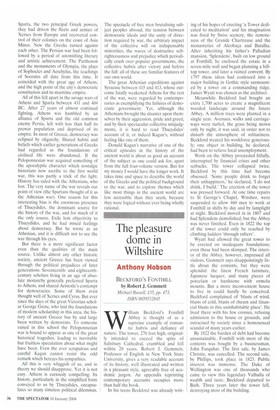The pleasure dome in Wiltshire
Anthony Hobson
BECKFORD'S FONTHILL by Robert J. Gemmett Michael Russell, £35, pp. 473, ISBN 0859552845 William Beckford's Fonthill Abbey is thought of as a supreme example of romantic hubris and defiance of nature. The tower, 276 feet high, originally intended to exceed the spire of Salisbury Cathedral, crumbled and fell within 20 years. Robert J. Gemmett, Professor of English in New York State University, gives a very readable account of its history, well illustrated and written in a pleasant style, agreeably free of academic jargon. An appendix reprinting contemporary accounts occupies more than half the book.
In his teens Beckford was already writ
ing of his hopes of erecting 'a Tower dedicated to meditation' and his imagination was fired by Swiss scenery, the remoteness of the Grande Chartreuse and the monasteries of Alcobaca and Batalha. After inheriting his father's Palladian mansion, `Splendens', built on low ground at Fonthill, be enclosed the estate in a seven-mile wall and began planning a hilltop tower, and later a ruined convent, By 1797 these ideas had coalesced into a major building in Gothic style surmounted by a tower on a commanding ridge. James Wyatt was chosen as the architect.
Meanwhile Beckford had bought an extra 1,700 acres to create a magnificent wooded landscape around the future Abbey. A million trees were planted in a single year. Avenues, walks and carriageways were turfed, the grass being mown only by night, it was said, in order not to disturb the atmosphere of solitariness. Beckford treated his workforce generously; one object in building, he declared, had been to relieve local unemployment.
Work on the Abbey proceeded fitfully, interrupted by financial crises and other setbacks. The tower collapsed twice. Beckford by this time had become obsessed. 'Some people drink to forget their unhappiness,' he declared, 'I do not drink, I build.' The erection of the tower was pressed forward. At one time repairs to St George's Chapel, Windsor, were suspended to allow 460 men to work at Fonthill in shifts by day and by lamplight at night. Beckford moved in in 1807 and had Splendens demolished; but the Abbey was never finished. Even in 1822 the top of the tower could only be reached by climbing ladders 'through rafters'.
Wyatt had allowed the great tower to be erected on inadequate foundations; even these had been skimped. The interior of the Abbey, however, impressed all visitors. Gemmett says disappointingly little about the contents, but they were splendid: the finest French furniture, Japanese lacquer, and many pieces of porcelain or hardstone with ormolu mounts. But a more inconvenient house to live in could hardly be conceived. Beckford complained of 'blasts of wind, blasts of cold, blasts of rheum and financial blasts in this uninhabitable place'. He lived there with his few cronies, refusing admission to the house or grounds, and ostracised by society since a homosexual scandal of many years earlier.
By 1822 the burden of debt had become unsustainable. Fonthill with most of the contents was bought by a businessman, John Farquhar. The first sale, by James Christie, was cancelled. The second sale, by Phillips, took place in 1823. Public interest was immense. The Duke of Wellington was one of thousands who came to view this legendary Valhalla of wealth and taste. Beckford departed to Bath. Three years later the tower fell, destroying most of the building.


























































 Previous page
Previous page